A New Era for Australia’s Migration Vision
Australia Migration Program 2025–2026 begins a transformative chapter in the country’s immigration journey. The government has announced refined planning levels, targeted skilled visa allocations, and fresh policy priorities designed to fuel economic growth while addressing workforce shortages.
This update reflects a balance between skilled migration, family reunification, and humanitarian goals — all while making the pathway to Permanent Residency (PR) more efficient and transparent.
If you’re planning to migrate to Australia in 2025 or 2026, this guide will walk you through every important change, visa category, and opportunity available.
Australia Migration Planning Levels 2025–2026
The Australian government has set an ambitious migration planning level of around 190,000 places for the 2025–2026 program year.
Here’s how the allocation is expected to be distributed:
| Stream | Estimated Places | Focus |
|---|
| Skill Stream | 132,000 | Address labor shortages in key industries |
| Family Stream | 58,000 | Support family reunification |
| Special Eligibility & Humanitarian | Balance | Maintain fairness and compassion in global migration |
Australia Migration Program 2025 reflects the government’s aim to strengthen both the economy and communities through sustainable immigration.
Key Priorities in the Australia Migration 2025–2026 Program
The new program emphasizes four major pillars shaping migration outcomes:
1. Skilled Migration for Economic Growth
Australia continues to prioritize skilled professionals who can fill labor gaps in critical sectors — such as healthcare, engineering, construction, and IT.
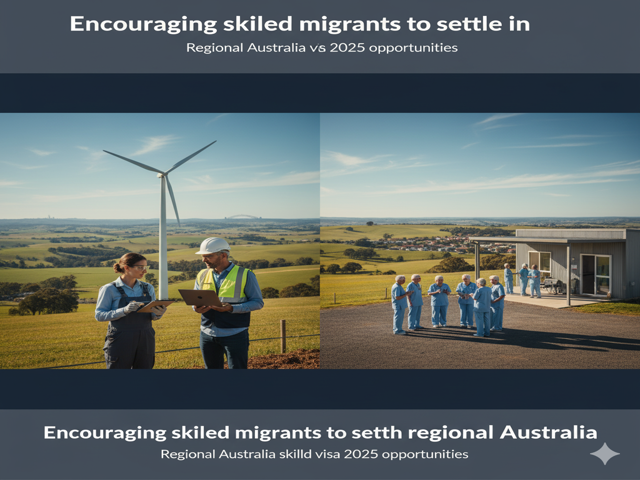
The General Skilled Migration (GSM) stream, which includes Subclass 189 (Independent), 190 (State Sponsored), and 491 (Regional) visas, remains at the forefront.
2. Regional Development Initiatives
To reduce urban congestion and promote balanced growth, the government is allocating 25% of skilled migration places to regional areas. This encourages new migrants to live and work in Australia’s regional communities.
3. Simplified PR Pathways for Temporary Residents
Temporary visa holders such as international graduates and temporary skilled workers can expect streamlined pathways to Permanent Residency.
4. Family Reunion and Social Integration
Family-sponsored visas — including Partner, Parent, and Child categories — remain essential to Australia’s compassionate immigration framework.
Top Visa Categories Under Australia Migration Program 2025–2026
The Skill Stream continues to dominate migration targets. Below are the main categories you should know:
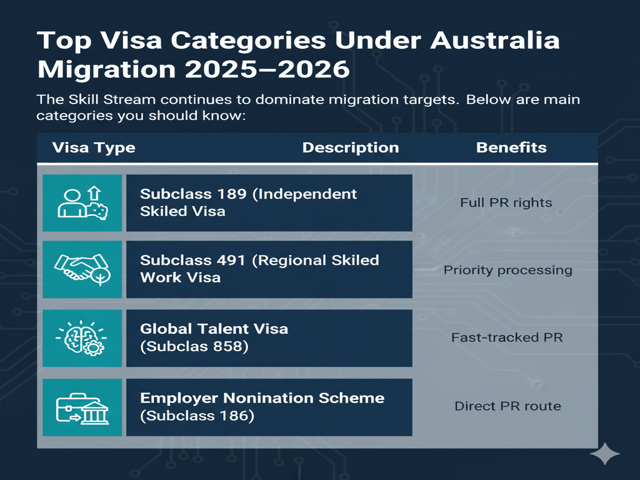
| Visa Type | Description | Benefits |
|---|
| Subclass 189 (Independent Skilled Visa) | For highly skilled workers not sponsored by employers | Full PR rights |
| Subclass 190 (State Nomination) | For migrants nominated by state governments | Priority processing |
| Subclass 491 (Regional Skilled Work Visa) | For professionals willing to live in regional zones | PR after 3 years |
| Global Talent Visa (Subclass 858) | For high-achieving professionals in innovation & tech | Fast-tracked PR |
| Employer Nomination Scheme (Subclass 186) | For workers sponsored by Australian employers | Direct PR route |
Read more about Australia Skilled Independent Visa (Subclass 189) on the official government website.
Strategic Occupation Lists for 2025–2026
The Skilled Occupation List (SOL) is being revised to match Australia’s evolving labor needs.
Key in-demand professions for 2025–2026 include:
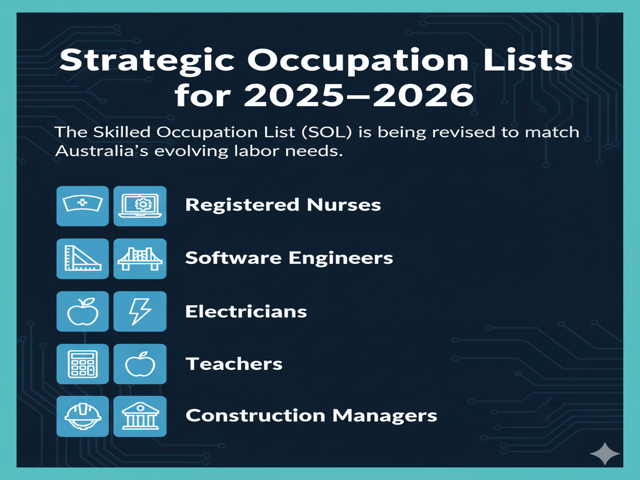
- Registered Nurses
- Software Engineers
- Civil Engineers
- Electricians
- Teachers
- Accountants
- Construction Managers
These updates ensure that the Australia Migration Program 2025–2026 directly supports sectors driving post-pandemic recovery and innovation.
Employer Sponsorship & Workforce Reforms
Australia is refining its Temporary Skill Shortage (TSS) and Employer Nomination Scheme (ENS) visas to provide more flexibility for employers while protecting workers’ rights.
Employers will enjoy faster sponsorship approvals if they demonstrate compliance history, while sponsored employees can expect clearer pathways to PR.
International Students: Post-Study Opportunities
For international graduates, the Temporary Graduate Visa (Subclass 485) continues to be a key bridge to permanent migration.
In 2025, the visa will see optimized post-study work durations, regional bonuses, and simpler transitions to skilled visas.
Example: Graduates from Australian regional universities may get 2 additional years of post-study work rights.
Australia PR 2025: A Balanced, Sustainable Approach
The new system balances skilled migration with humanitarian obligations, while ensuring economic sustainability.
Australia PR remains a top choice for global migrants due to benefits like:
- Access to Medicare
- Permanent work rights
- Education subsidies for dependents
- Pathway to citizenship
Digital Transformation in Visa Processing
Australia’s Department of Home Affairs is expanding AI-based visa screening tools to reduce delays and human error.
By 2026, most visa categories will move toward online document verification and faster e-approval systems, ensuring transparency and speed.
Family Migration 2025–2026: Reuniting Loved Ones
Family migration accounts for nearly one-third of the total intake.
Key categories include:
- Partner Visas — for married or de facto couples
- Parent Visas — with focus on balance-of-family tests
- Child Visas — for dependent children of PR holders
Processing times are expected to improve as online lodgment systems expand globally.
Humanitarian and Refugee Commitments
Australia remains committed to its humanitarian intake, supporting refugees from crisis regions under a 27,000-person ceiling.
Programs include community sponsorships and regional resettlement, reinforcing Australia’s global leadership in humanitarian support.
Australia Migration Program 2025–2026: What It Means for You
If you’re planning to migrate to Australia in 2025–2026, here’s what you should prepare for:
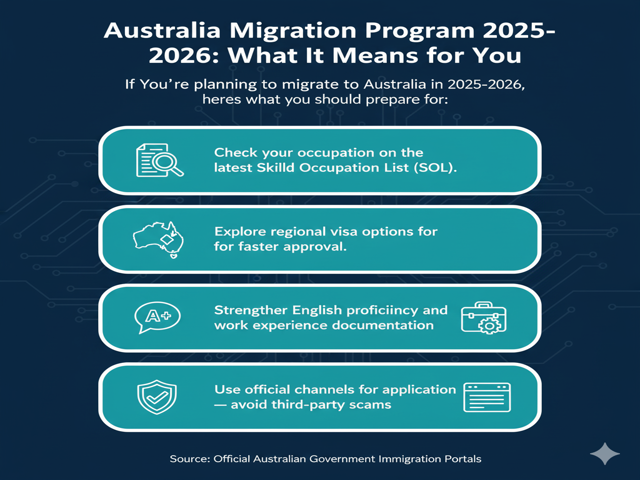
- Check your occupation on the latest Skilled Occupation List (SOL).
- Explore regional visa options for faster approval.
- Strengthen English proficiency and work experience documentation.
- Use official channels for application — avoid third-party scams.
Expert Insights: Future of Australia Migration Program 2025–2026
Experts predict that by 2026, Australia will witness a shift toward tech-driven visa management, regional expansion, and smarter PR systems.
The migration focus will increasingly align with the country’s economic resilience strategy and climate adaptation policies.
Read also: US Immigration Reform 2026: Powerful New Changes Ahead
FAQs About Australia Migration Program 2025–2026
Q1: What is the total migration cap for 2025–2026?
A: The government has set a planning level of approximately 190,000 places across skilled, family, and humanitarian streams.
Q2: Which visa is easiest for PR in 2025?
A: The Subclass 190 (State Nominated) and Subclass 491 (Regional) are currently the fastest-growing PR pathways.
Q3: Will regional visa applicants get preference?
A: Yes, regional migration continues to receive strong incentives and faster PR transitions.
Q4: Are there any changes for international students?
A: Yes, post-study work visas have been extended for select graduates and regions.
Q5: Can temporary residents apply for PR more easily now?
A: Absolutely — Australia’s focus is on streamlining temporary-to-permanent transitions.
Agent Advise: Australia Migration Program 2025–2026 Future Is Bright
The Australia Migration Program 2025–2026 stands as a forward-thinking blueprint for sustainable growth, skill development, and social cohesion.
Whether you’re a skilled worker, student, or family applicant — this program offers expanded opportunities,digital efficiency, and a clearer PR pathway than ever before.


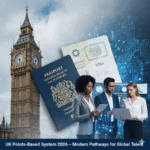

Pingback: UAE Golden Visa 2026: Exciting Expanded Eligibility
Pingback: Portugal Golden Visa 2026: Powerful New Investment Policy
Pingback: Climate Skills Visa 2026: Powerful Green Workforce Mobility